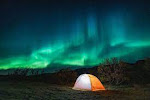The Great Conjunction And Palindrome Day Happen Only Once-In-10-Lifetimes
Traveling is not yet possible, so we will just wistfully talk about a different style of traveling. And this is a unique one.
Traveling in time is also an exciting adventure to learn and explore, for it awakens a curious mind and reconnect our senses to the soul of the earth.
Today, we're up for some unique time of the year, a time that only happens once-in-10-lifetimes. So, it feels like we're journeying back to the day the earth is still quiet and peaceful and full of loveliness.
Time travel indeed is a great healing adventure of the soul, a way to find our balance in a time shrouded with uncertainty and distress.
Unique moment in time
Something spectacular is happening in the sky tonight. It's the great conjunction of Jupiter and Saturn and will take place on the winter solstice!
The year 2020 has never short of surprises and things to frighten and delight us. It's quite a story. Both tragic and strange.
Apart from the pandemic and brutal natural disasters, there are phenomena this year that only occurred once-in-10-lifetimes.
So can we considered ourselves lucky enough to witness it? It's the most difficult time we have ever experienced in recent decades, and for baby boomers, since World War II.
But we have our strength. We have our courage. With so many challenges we already endured in the past, not once we have ever given up. So we can win this battle. We can get through this difficult time.
One day, things will get better again. And today, December 21st is the beginning of the great wisdom because we're witnessing an event that hasn't happened in almost 400 years.
The great conjunction in winter solstice is such a fascinating phenomenon in the sky but it also symbolizes hope, life, and a beautiful beginning because it's the Christmas Star we're seeing in the sky later this evening.
For Christianity in the entire world it is a clear message that God has not forsaken us during this difficult moment. The Star of Bethlehem will appear, just four days before Christmas. Nothing more wonderful this moment than this great message of hope.
It means the year is not all about disappointment, misfortunes and virus, this is also the year of hope and going back to ourselves, reassessing our purpose and commitment for a healthier planet. And we still have life, we are still living and that's enough to be grateful this year.
As we go down the final stretch of the year, we come to terms with the fact that traveling freely or taking adventure somewhere is no longer possible at the moment. So perhaps, traveling with our naked eye to the milky way is a great consolation.
There are two phenomena this year that only occurred once in a 10 lifetimes, so to speak, and we're lucky enough to experience it.
Palindrome Day
On February 2, 2020, the palindrome day occurred, the only time in the century that such date will occur. The last time was more than 900 years ago.
February 2, 2020 is a numeric palindrome, 02022020, which means that number remains the same when its digits are reversed.
It won't happen again until 101 years later, on December 12, 2121. More about Palindrome day, check this link
The Great Conjunction
Winter is coming!
Although winter begins on December one in the Northern Hemisphere, astronomers would agree that it begins on the solstice or the longest night of the year, which means December 21st this year. It's a phenomenon where earth tilts away from the sun longer than in any time of the year, giving us a longer night.
And what an event! It also coincides with the great conjunction, the closest passing of the two gas plants, Jupiter and Saturn, which has not taken place in almost 400 years.
It's a rare celestial event which many believed, the possible source of the "Star of Bethlehem" or the "Christmas Star" mentioned in the nativity story of Christianity.
This great conjunction won't happen again until the year 2080, so this might be our last chance to witness this rare phenomenon in the sky.
It is called the great conjunction because Jupiter and Saturn are the two largest planets in the solar system and when they pass closest to each other, they will form like a single, brightest and biggest star in the horizon.
How to witness this event?
According to reports, just look up Southwest of the silhouette sky after sunset on December 21. As the twilight comes, Jupiter and Saturn will slowly pass each other, with the earth's satellite, moon, gazing from the horizon.
The conjunction will last only for 45 minutes as the two planets will continuously rotate around the solar system, pulling from each other's away.
This will be the closest encounter of the two giant planets in the solar system since the year 1623. This conjunction is visible around the world over the clear sky and people can see it with the naked eye.
After sunset, the two planets will briefly appear as a single star and will shine the biggest and brightest. Astronomy experts thought this could be the possible source of the "Star of Bethlehem", in the biblical nativity story that appeared in the Gospel of Matthew.
Near Yet So Far
However, according to astronomy experts, while Jupiter and Saturn may appear closest to each other on December 21, in reality, they are hundreds of millions of miles apart.
The two gas planets, which are the biggest in the solar system, are gradually moving to each other's axis since last week. Jupiter is fast catching up Saturn and finally overtaking it today, December 21 after sunset.
Their passing through, will form a single bright spot in the sky, also referred by astronomers as "The Christmas Star", because they will align with the earth, thus allowing us to view it like the brightest object in the sky.
Saturn and Jupiter's orbits bring the planet into alignment every 20 years but this year is the closest they will ever come since the 17th century.
Winter solstice
As December 21st is the winter solstice or the longest night of the year, people will have the chance to explore the night sky with the naked eye, longer.
The Earth's axis tilts 23.5 degrees from the vertical. And as it rotates in the solar system, half of the globe receives the sun's light while the other half swathed in shadow.
However, twice a year, the tilt becomes extreme, half of the globe will have a longer day (summer solstice) while the other half has the longest night (winter solstice).
Ever wondered what "solstice" means?
It's an amalgamation of the Latin words "sol" which means sun, and "stare" which means stand still, according to the Franklin Institute.
So today, we have a great earth's phenomenon to witness. The great conjunction during the longest night of the year, with just four days before Christmas. A great message of hope, heralding a new beginning.
This rare occurrence will never happen again in our lifetime. So make it count!














0 Comments